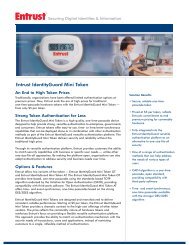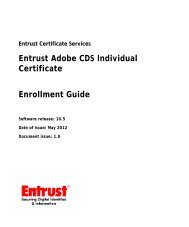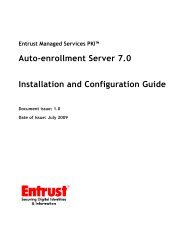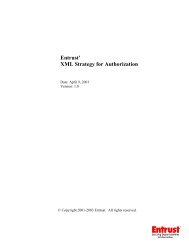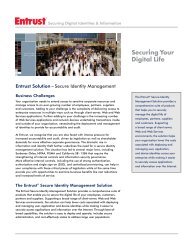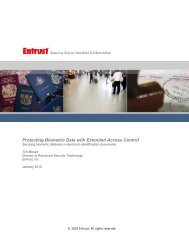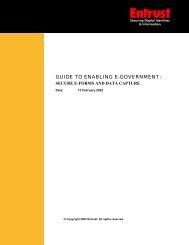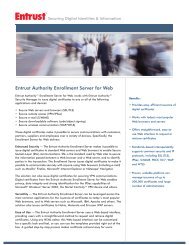X.509 Certification Path Validation - Entrust
X.509 Certification Path Validation - Entrust
X.509 Certification Path Validation - Entrust
You also want an ePaper? Increase the reach of your titles
YUMPU automatically turns print PDFs into web optimized ePapers that Google loves.
<strong>X.509</strong> certification path validation <strong>Path</strong> validation<br />
3.2 THE PATH VALIDATION PROCESS<br />
The path validation process consists of a number of individual processes that fall into three basic<br />
categories: path structure, certificate validity and business controls. There is no specific order in which the<br />
individual processes must be executed. However, because many of the business controls imposed<br />
through infrastructure constraints affect subsequent certificates in the path, there is a requirement to<br />
process certificates in the exact order they appear in the path beginning with the certificate that was<br />
signed by the relying party’s trust anchor and ending with the subscriber certificate. [<strong>X.509</strong>] and [PKIX]<br />
both include an outline of a procedure for path validation in their standards. While standard conformance<br />
demands that an implementation be functionally equivalent to the external behavior resulting from those<br />
outlines, it is not mandatory for implementations to use either of those algorithms directly.<br />
3.2.1 <strong>Path</strong> Structure Processes<br />
<strong>Path</strong> structure processing consists of four tests. These tests ensure that the certification path is properly<br />
constructed. If all certificates in the path pass these tests, then the certification path is a proper path in<br />
that the intermediate entities are all CAs and the path forms an unbroken chain of certificates to the<br />
subscriber public key. If any of these individual processes fails, then the path validation process fails.<br />
3.2.1.1 Name Chaining<br />
Name chaining involves comparing the value of the subject field in one certificate with the issuer field in<br />
the subsequent certificate. For each pair of adjacent certificates in the path, these values must match.<br />
This check ensures that the certification path is truly an unbroken chain of entities relating directly to one<br />
another and that it has no missing links.<br />
3.2.1.2 Key Chaining<br />
Key chaining involves checking that the key certified in each certificate verifies the digital signature on the<br />
subsequent certificate. This check establishes cryptographic trust from the relying party’s trust anchor to<br />
the subscriber’s public key. Ensuring that the value of the subjectKeyIdentifier extension in one<br />
certificate matches the value of the issuerKeyIdentifier extension in the subsequent certificate<br />
contributes to the key chaining process.<br />
3.2.1.3 Duplicate Certificates<br />
The duplicate certificate process involves checking to ensure that each certificate appears only once in<br />
the path. If the path includes two certificates that have matching issuer names and identical serial<br />
numbers, then they are considered duplicates. This check ensures that a loop does not adversely alter<br />
the effect of business controls, changing the outcome of proper path validation. For example, a duplicate<br />
certificate could impact the path length controls (see Section 3.2.3.3).<br />
3.2.1.4 Subject Entity Type<br />
CAs are the only legitimate issuers of certificates. Therefore, each certificate in the path, except the<br />
subscriber’s certificate, needs to be checked to ensure that its subject is also a CA. This check is<br />
performed by ensuring that the basicConstraints extension is present in the certificate, with the cA<br />
element set to TRUE. For some transactions, such as verifying the digital signature on a CRL, the<br />
subscriber of interest is itself a CA while in most other transactions the subscriber of interest is not a CA.<br />
Therefore this check is not required on the subscriber’s certificate.<br />
3.2.2 Certificate Validity Processes<br />
Certificate validity processing ensures that each certificate is a valid <strong>X.509</strong> public-key certificate and that<br />
the basic requirements for use of the public key are satisfied. If any of these processes results in failure<br />
for any certificate in the path, the path validation process fails.<br />
3.2.2.1 Syntax Check<br />
The syntax for certificates is defined in [<strong>X.509</strong>]. This includes a set of base certificate fields and an<br />
extension capability that enables additional information to be conveyed. Each certificate extension defines<br />
its own syntax. A standard set of extensions is specified in [<strong>X.509</strong>] and [PKIX]. The syntax of all base<br />
certificate fields as well as all known extensions must be checked to ensure the syntax of each conforms<br />
© Copyright 2004 <strong>Entrust</strong>. www.entrust.com<br />
All rights reserved. Page 8



